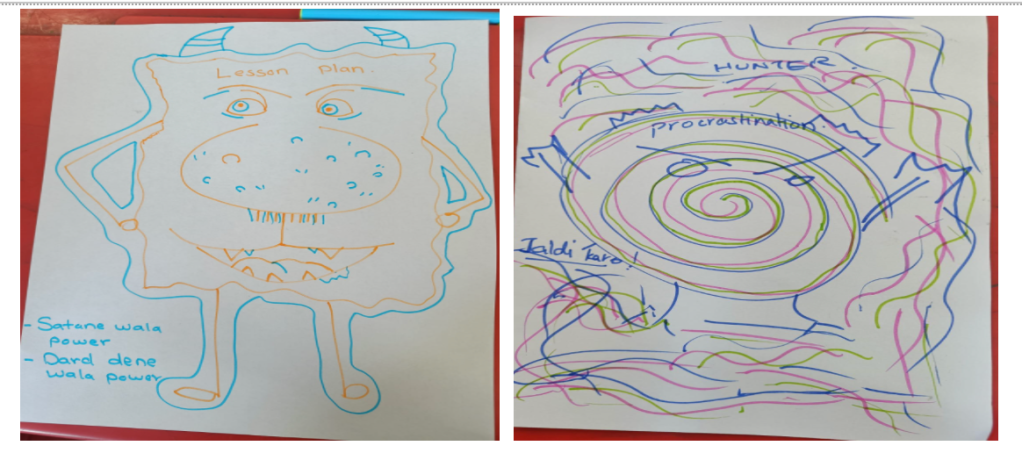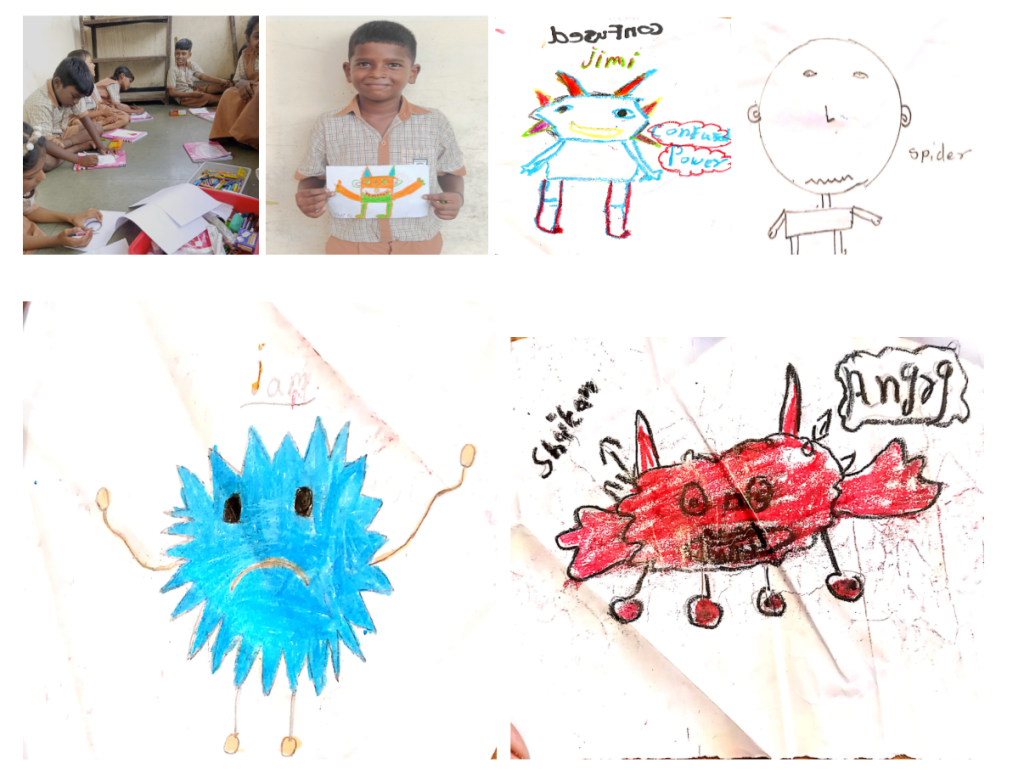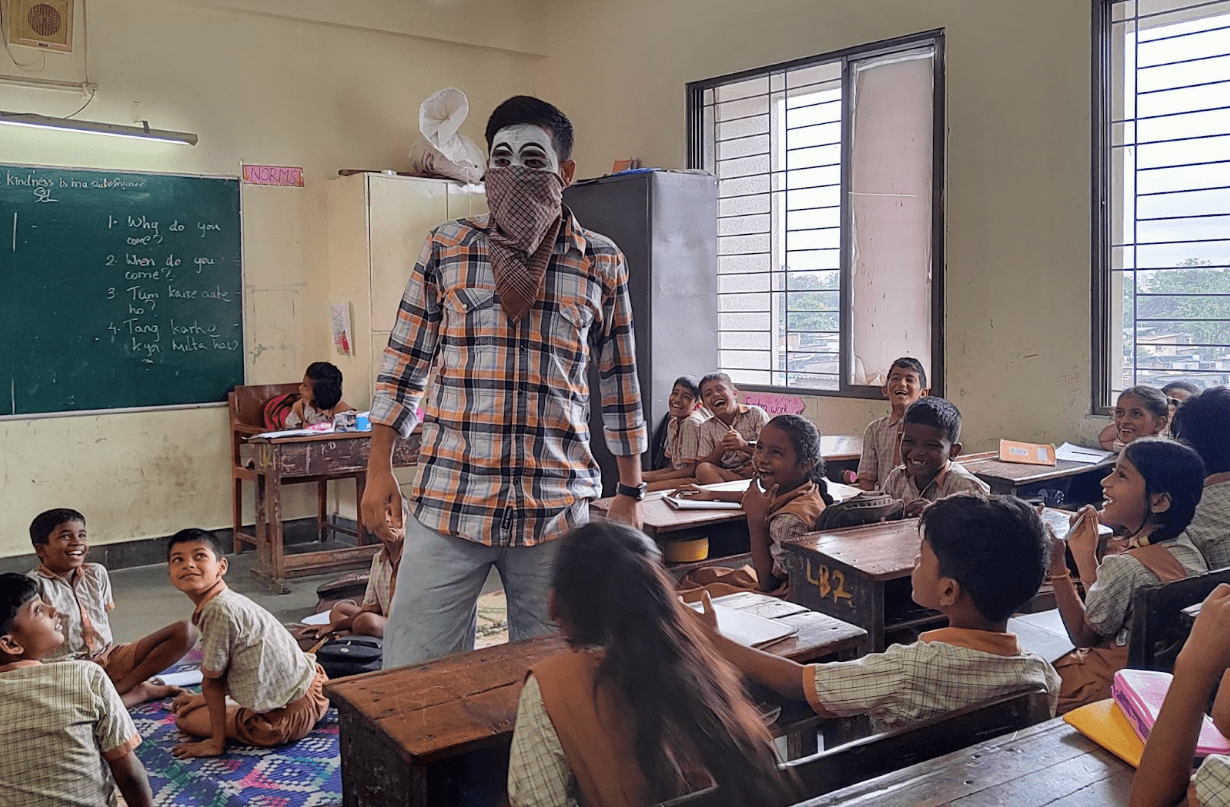A practice-based reflection piece by Kavya and Safeer.
On a pleasant monsoon evening, the authors of this blog, Safeer and Kavya, walk home from the office. Safeer asks, “What do you think we can write together for our blog?” Since they were interested in Narrative practices, Kavya suggested they collaboratively write on planning and implementing SEL practices in classes. They smiled as they got excited and carried on to their Saturday meetings. They looked at the curriculum and objectives, planned activities, and finally took it into class.
Introduction
Khoj is a Social-emotional learning-(SEL)-integrated educational initiative implemented in partnership with Mumbai’s public school system and local communities. Khoj’s education model is experiential and multicultural and incorporates diversity and inclusion practices, Narrative Practices*, and multilingual instruction with a curricular focus on students’ wellbeing and development.
One of the core ideas of Narrative practices is that ‘people are not the problem, the problem is the problem’; problems aren’t rooted within people but within systems that govern our lives. For example, when treating someone who had broken the law, Narrative practitioners would encourage the individual to see themselves as a person who made mistakes rather than an inherently criminal person.
Creating spaces in class where students can see the problem and its effects from a distance is essential so they don’t see the problem as a part of their identity. The school has taken great strides to get to the heart of issues causing distress to its student community with the understanding that the problem is commonly the result of oppressive systems.
Externalisation Map from Narrative Practices
Externalising conversations supports students in identifying and naming the problem, using their experience of the problem. The student is encouraged to map and evaluate the effects of the problem in their life. The student then gets to delve into the stance they have on the problem and why they have taken this stance towards the problem. Finally, the focus shifts to creating a step or action, having understood the problem’s influence. The steps for action they make help them move towards their preferred way of engaging with this problem. This facilitates building a rich story of their life and not just the single story that the problem has them believing. Ex – From I am an “inherently confused person” to move towards – “feelings of confusion visit me sometimes”.
Teachers at Khoj are encouraged to work on integrating themes across subjects, rather than looking at subjects as separate from one another. We work on nurturing five core competencies informed by the CASEL framework through the SEL-integrated approach within school culture and curriculum.
Planning and Implementation
As Facilitators, we were very excited to witness the outcome of this activity and what characters and shapes students perceive their problems to have. We planned to work with grade 4 students between 9 – 11 years old. The first step was to map commonalities in the objectives for the month towards building English, Art and SEL integrated classes. Below are some of the mapping objectives for September for each of these subjects:
| ART | SEL | ENGLISH |
| Students will be able to – (1) recognise and label emotions.- Students will be able to give shape to their feelings.- (2) Students will be able to choose and give a color to feeling and the problem.- Students will be able to explore paper folding techniques. | Under the theme of ‘Celebrating Uniqueness’, students will be able to (1) recognize the judgment/reactions that come towards our feelings, thoughts, and experiences.- (2) Be able to understand and manage their emotions. | ‘What helped me relax when I was angry/nervous/scared/sad/ confused’. – Imagining, Inferring, talking about character feelings through visual and contextual clues. – Beginning the concept of ‘journaling feelings’ – Responding in complete statements to ‘Wh’ questions.- Writing ‘wh’ questions in complete statements. |
Facilitatorss’ pre-work
As facilitators for this particular activity, we prepared the following before taking it to class. We understood externalisation by reading the beautiful book. ‘Ruby’s Worry’ by Tom Percival. We then externalised our small problems and did narrative interviews with each other. Below are images of our externalized problems.

Image Description: Image on the left: Meet khachumbadh! Kachumbar looks like SpongeBob, he scares me when I feel rushed. Image on the right: Meet hunter! Hunter looks like whirlpools of water; hunter hides behind me and keeps whispering all the work yet to be done!
Flow of the activity
| Day 1 Objective | Activity |
| – SWBAT (Students will be able to) recollect known feelings.- SWBAT differentiate between feeling that visit them sometimes (kabhi kabhi feelings) and feeling that visit for a long time (lambe samay wala feeling)- SWBAT will be able to identify a feeling they have difficulty processing/engaging with.- SWBAT will be able to externalize a feeling they have difficulty processing/engaging with. | – As warm up students say and act out the feeling names they already know.- Students use paper folding methods to understand the difference between feelings that visit them sometimes (kabhi kabhi feelings) and feelings that visit for a long time (lambe samay wala feeling).- Students look at the feeling chart to identify and write the feeling they have difficulty processing.- Students write and draw the feeling they have difficulty processing as a character using narrative prompts. |

Image Description: On the left, students act out feelings as a warm up activity. On the right, Students differentiate feelings that visit them sometimes and feelings that visit them for a long time.

Image Description: Students give a shape and character to the problem.
| Day 2 Objective | Activity |
| – SWBAT (Students will be able to) make a deeper understanding of the externalized feelings in groups – SWBAT reflect and tell the effects of externalized feelings in groups. – SWBAT think of one step to respond to the externalised feeling in groups. – SWBAT respond to narrative questions about externalised feelings in groups. | Students focus group interviews on externalised problems using the following narrative questions: 1.When did you first notice the problem? 2.What in particular did you notice the problem doing? Do you think the problem has a particular “tone” of talking? 3.How does the problem affect you on a day to day basis? 4.When you think about what you have just said about what is important to you? Can you think of a small step you could take in that direction? We chose these questions keeping in mind the context and histories of our students. We planned for and scaffolded check-ins into the activities. These questions might not work for a different context. |

Image Description: Look at how young people at Khoj responded to the externalized problems!
Student K – ‘Mere mushkil ka naam hai Pinky peepky, uski awaz moti hai, me jab padhai karta hu mujhe pareshan karta hai, kabhi accha rehta hai kabhi kabhi bura, jab use ghussa aatahai masti karta hai, ye galat hai, usse uske jagah par bhej dunga waha wo safe rahega phir me mera kaam bhi kar sakta hu.’ My problem’s name is Pinky Peepky, it has a big voice and irritates me when I study; it is good sometimes and sometimes bad. I think this is wrong so I will send it to its own place where she will be safe and I will be able to do my work..
Student R – ‘Mere mushkil ka naam hai Chulbuli. Wo ek dum gusse se baat karta hai mujhe darata hai, me jab homework krta hu muje bolta hai khelo, khelo. Me jab bhi kaam karta hu wo bigad deta hai, mujhe dohdata hai, ye galat hai. Me usko uske duniya me chod dunga or wo mujhe pareshan nahi karegi mujhe homework karne milega.’ My problem’s name is Chulbuli. He talks to me with a lot of anger and scares me, he asks me to play when I try to do my homework. This is wrong. I will leave him in his world and then I will get to do my homework without feeling irritated.
Student M – Mere Mushkil ka naam hai Cheru. Khoj yatra ke samay maine usse notice Kiya. Jab Mera speech tha us din mujhe bahut nervous feel karti thi, jab bhi me confident rehti thi tab ye mujhe nervous feel karratha. Yeh mujhe help nahi kr raha hai. Me uski baat sunungi he nahi. Nervous ki jagah confident feel karunga aur Jo log mujhe appreciate kar rahe hai un par dhyan dungi or confident rahungi. My problem’s name is Cheru. I noticed her during Khoj Yatra. She made me very nervous during my speech. She does not help me; Next time I won’t listen to her and feel confident instead of feeling nervous.
Student N – ‘Mere mushkil ka naam hai XRAli43 . Pehli baar sapne mai aya tha. Aaaaaaa karke yeh awaz nikalta hai. Neend lata woh, sapne me bahut zayada pareshan karta hai. Mera mushkil jab gusse mai rehta hai woh bolta hai padai mat kar aur help nhi karta hai. Agli baar ayega tho bahuduri dikunga .. chappal nikalke marunga.’ My problem’s name is XRAli43. I noticed him in my dreams for the first time. He has an aaaaaaa sort of voice. He puts me to sleep and disturbs me in my dreams as well. Next time I will be brave and hit him with a slipper.
| Day 3 Objective | Activity |
| – SWBAT think as a class and ask questions to the feelings they have difficulty processing.. | Students recollect externalized feelings and collectively think and document questions they want to ask externalized feelings. |
Questions students had for the externalised problem.
- Why do you come to us?
- When do you come to us?
- How do you reach?
- What do you get by causing trouble?
The above questions informed the next day’s plan. The facilitators observed that as a class they have responded and spoken about feeling angry, confused, tired, happy, excited but not as much about feeling sad. As many students had externalised feelings of sadness the facilitators took a call to respond to it as a class.
| Day 4 Objective | Activity |
| – SWBAT talk and ask questions to ‘sad feeling.’ | Pre work to the activity – Facilitators used the above question and scripted the answers to these questions and for ones anticipated for a drama activity. – Teacher dresses up as ‘sad feeling’ and visits class and answers student’s questions. |

Image Description: Safeer as Sad bhaiya!
Practice of care and excitement in an SEL classroom through modeling and reflections.
Before doing the focus group discussions with the students, as co-facilitators, we interviewed each other about our own externalized problems in class before we interviewed the students; we wanted to become vulnerable in class and talk about the problems so that there could be a space if students wanted to share their own.
From Safeer’s year-long observation of the class, he understood that there are things to keep in mind when working with emotions in the classroom and the values of care and compassion that should guide the planning for SEL classes. We know our students have gone through grief and loss; we had to be very careful while talking about and choosing feelings that they have difficulty processing. For example, student X can externalize feelings of sadness but not grief, as it might be too heavy to process during class. Hence, it was necessary to differentiate for ourselves and for our students, feelings that visit them sometimes and feelings that visit us for a long time; we scaffolded the activity to make this possible. We also checked in with the students during multiple points of the activity. Enough check-in time allowed this activity to be done with much excitement.
The students in this grade at Khoj have had SEL classes for five years now; talking about their feelings and being reflective about them is a skill they have worked on and one that is visible in class. It’s been amazing to witness the agency of young people in this class. A teacher once said that one needs space to practice agency. This activity has created a space for precisely that.
Safeer says he was unsure of art and literacy integration, but when we started, our excitement gradually increased. We used paper folding to explain the feelings that visit us sometimes and ones that visit us for a long time; it was magical to see that students spontaneously made origami and started saying that feelings that visit them for a long time, the one that causes them trouble looks like a rocket, a fan, a snake and crow. Safeer adds that when he got ready for the last activity, he got a call from Kavya saying that students were very excited to meet the visitor he was going to portray. Once he entered class, students were surprised and happy; they started to ask questions, and he loved responding to them. One of the students asked “sad wale bhaiya apka dost kaha hai, happy wala bhaiya?” He happily answered, “He is always with you when you find a step to manage a problem. He will come to visit you.” Safeer also reflects that he was confused about how to dress up as sad bhaiya and what to take and not take.
Kavya observes that though the plan was debriefed with three of the facilitators involved, they struggled being on similar lines during implementation; creating enough time to discuss with facilitators regarding being on the same page will help with consistency through the classes. The facilitators saw that the art and SEL objectives were met throughout the week, with the literacy objectives where students were to think and write of ‘wh’ questions to the problems; while they were able to do that in groups, they needed more support in doing it individually; more time and scaffolds in the activity would have helped to practice that skill more.
As Safeer sits during student exit on the last day of the activity, he hears students saying, ‘sad bhaiya bye bye!’ He observes a shift in students’ perception of ‘sadness’; maybe they may be able to say the same thing the next time sad feelings visit them. This activity has provided a space for the class to engage with an increasing growth mindset and explore and learn new things.
About the authors
Kavya is a primary school teacher at Khoj. She holds a Master’s degree in Education from Azim Premji University; she is an aspiring educator with interests in SEL, experiential and alternative pedagogies. She has spent time working with rural and marginalized communities in different parts of India. She has a special love for cooking and birding. She also enjoys a bit of travel and adventure! She aims to bring about fun and meaningful educational experiences for children.
Safeer Idrisi is an Art Teacher at Khoj, Apni Shala’s SEL-integrated school initiative. He holds an art teacher diploma and has experience teaching young children art and crafts. He has a passion for art and loves to share it with his students. He is eager to help his students have positive and successful experiences in the art room. Besides that, Safeer loves food and traveling.
References
- Ruby’s worry by Tom Percival.
- Boy and the Gorilla by Jackie Karmer.
- When I feel sad by Cornelia Maude Spelman.
Acknowledgements
We are grateful to all those whom we have had the pleasure to collaborate with in bringing these activities to life. Shout out to our team members Aniket Magar and Rashmi Shinde who supported the facilitation and documentation process. We also want to express our gratitude to Sandhya Singh for the support and guidance through the review process. Finally, a special thanks to Narrative Practices India for providing a space for the facilitators to learn, discuss and build on these ideas!
* Narrative therapy (or Narrative Practices) is a post-modern form of psychotherapy that seeks to be a respectful, non-blaming approach to counselling and community work which centres people as the experts in their own lives. It views problems as separate from people and assumes people have many skills, competencies, beliefs, values, commitments and abilities that will assist them to reduce the influence of problems in their lives. To know more, click here.
